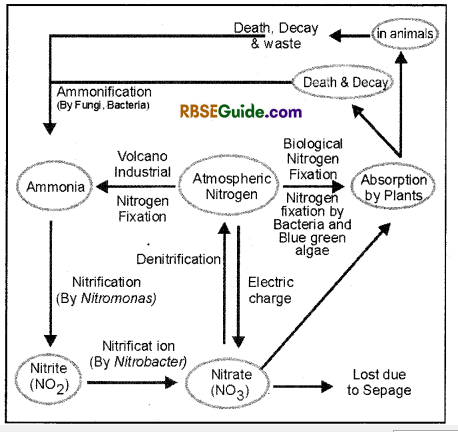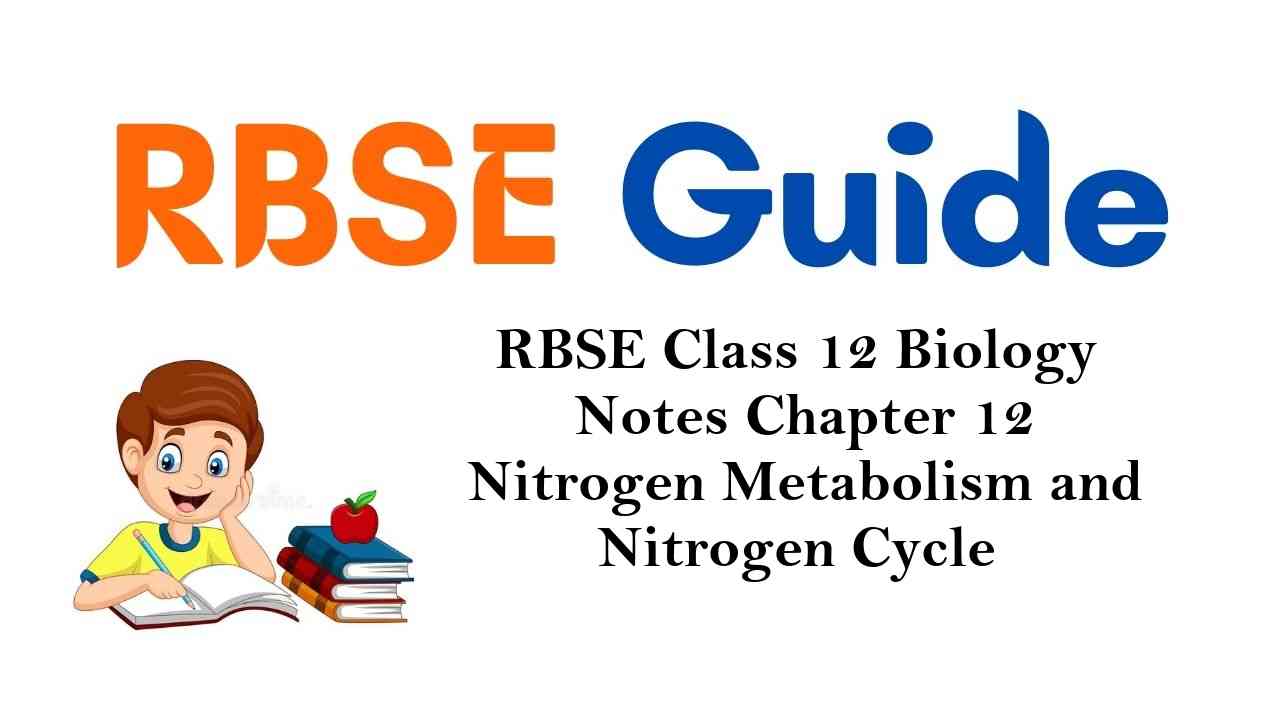Rajasthan Board RBSE Class 12 Biology Notes Chapter 12 Nitrogen Metabolism and Nitrogen Cycle
Introduction
1. Nitrogen is an important element found in all organisms. Nitrogen gas is found in largest amount in atmosphere amounting to about 78% of gaseous contents of atmosphere.
2. Nitrogen is a major component of proteins found in protoplasm. It is found as major component of various organic compounds such as nucleic acids, vitamins, enzymes, amino acids etc.
3. Nitrogenous compounds form about 5-30% part of total dry weight of the plant which indicates that besides C, H, and O, it is the most prevalent element in living organisms.
4. Deficiency of nitrogen results into several disorders in plants.
5. The free atmospheric nitrogen is not available to plants means it can not be used by the plants in this form.
![]()
6. Plants can use nitorgen absorbed from soil only where it is present in the form of nitrogen containing organic and inorganic compounds.
7. Higher plants and animals can not utilize free atmospheric nitrogen, but some bacteria, fungi, and blue green algae (Cyanophyceae) are capable of fixing atmospheric nitrogen. These microbes may be found in the form of symbionts or as free living forms in soil.
Note : Plants can utilize the following four types of nitrogenous compounds.
- Nitrite
- Nitrate
- Ammonia containing compound
- Nitrogen containing organic compounds.
8. Plants absorb nitrogen fixed by microbes (bacteria, fungi and blue green algae) and utilize in the synthesis of various organic compounds.
9. These compounds participate in cellular organisation and different metabolic activities of the cell.
10. From plants these organic compounds are passed on to animals and cycled back to soil and atmosphere where it may be used by other organisms.
11. This whole process is called nitrogen cycle.
![]()
12. This cycle operating in atmosphere is completed in four steps :
- Nitrogen fixation
- Ammonification
- Nitrification
- Denitrification
Nitrogen Fixation
1. In one molecule of nitrogen, two atoms are bonded by powerful trivalent bond and so nitrogen molecules are inert.
2. Breaking this bond and forming bonds with other molecule(s) requires high amount of energy.
3. The process by which free atmospheric nitrogen is converted into nitrogen compound is called nitrogen
4. The fixation of atmospheric free nitrogen is carried out by different methods. This can be explained with the help of following chart:
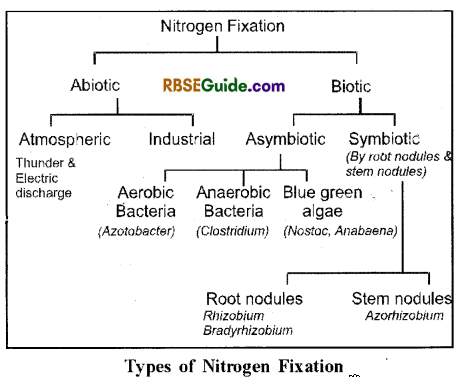
Abiotic Nitrogen Fixation
1. This type of nitrogen fixation takes place by natural processes due to environmental factors. This can be of two types :
2. Atmospheric N2 -Fixation : During electric discharge, and thunder and due to ultraviolet radiations, atmospheric nitrogen reacts with water and forms nitric acid.
3. Nitric acid further reacts with oxygen to form nitrogen di-oxide.
4. Nitrogen di-oxide reacts with water and forms nitrous acid (HNO2) and nitric acid (HNO3).
5. Subsequently this acid reaches soil with rain water and reacts with alkaline radicals to form nitrite and nitrates.
6. The nitrite and nitrates are soluble in water and are absorbed by roots.
![]()
7. This type of N2 fixation may account for about 10% of the total nitrogen fixation.
Reactions
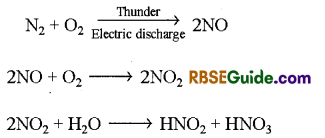
1. Industrial N2 Fixation : At very high temperature (200°C) and pressure, in the presence of catalyst, nitrogen combines with hydrogen to form ammonia (NH3). This method is used at industrial level to produce NH3 which is used in manufacture of chemical fertilizer.
2. This method of ammonia (NH3) formation is called Haiber method.
3. This method of N2 fixation is also called as chemical nitrogen fixation :

(A) Biotic Nitrogen Fixation
- The process of conversion of atmospheric nitrogen in to organic or inorganic nitrogeneous compounds by the micro-organisms is called biotic nitrogen fixation.
- These microorganisms are called Di-azotrophs because they convert atmospheric dinitrogen (N = N) in the form of nitrogen compounds.
Biotic N2 fixation is of two types :
(i) Asymbiotic N2 Fixation :
This type of N2 fixation is performed by free living microbes living in soil. The following free living microbes participate in the process of asymbiotic nitrogen fixation.
- Aerobic bacteria : Azotobacter, Azomonas
- Anaerobic bacteria : Clostridium
- Photosynthic bacteria : Chlorobium, Rhodopseudomonas
- Fungi: Yeast, Actinomycetes
- Blue green algae : Nostoc,Anabaena, or Cyanobacteria Oscillatoria, Plectonema
Note : In members belonging to blue green algae (Cyanobacteria), a special cell called Heterocyst is found which performs nitrogen fixation. Molybdenum element is required for the activity of these microbes.
![]()
(ii) Symbiotic N2 Fixation :
- In this type of N2 fixation, the microbes establish a mutualistic relationship with the plant.
- Rhizobium and Bradyrhizobium sps enters the roots of Leguminous plants and develop root nodules where they fix atmospheric nitrogen in nitrogen compounds.
- Similarly Azorizobium form stem nodules in Sesbania sps. and carry out nitrogen fixation.
- The microbe Frankia forms nitrogen fixing nodules in Almus (Anon-leguminous plant).
- In the leaves of Azolla (a pteridophyte) N2 fixation is carried out by Anabaena
Mechanism of Bacterial infection and Nodulation : Rhizobium is a Gram negative, rod shaped bacterium found in soil. The bacterium accumulates near the roots of specific leguminous plant and induces nodule formation. The establishment of symbiotic relationship between the root and Rhizobium is a complex process. Formation of nodules is completed by following steps.
(i) To begin with, the roots of leguminous plant secrete a specific glycoprotein (Sugar binding protein)-lectin. This lectin attracts specific Rhizobium towards roots.
(ii) Under the influence of plant hormone auxin and cytokinins secreted by the root and a Nod factor secreted by the bacterium attached to root hair, curling of root hair is induced and the root hair becomes hook shaped.
(iii) The cell wall near the tip of the hook shaped root hair becomes damaged (breaks) and through the broken wall the bacterial cells enter the root hair along with mucilagenous substance. Alter entry in to the root hair these bacteria are called bacteroids.
(iv) The plasma membrane of the invaded root hair becomes folded and forms a thread like structure called infection threads. The bacteroid keeps on multiplying in the infection thread and the infection thread penetrates the cortex cells. As the infection thread penetrates the cortex cells, the amount of DNA in the nucleus of the cells of outer cortex increases due to polyploidy induced in the cells of outer cortex.
These polyploid cells produce the nodule by repeated cell divisioins. The size of the nodules increases by the impact older (Indole acetic acid) secreted by the bacterial cells.
![]()
(v) After formation of nodule, vascular tissue develops in it and connects with the vascular tissue of the root. The bacteroid present in the active and functional nodule contain a pigment called leg haemoglobin in the peribacteroid membrane. Due to this pigment these nodule appear pink coloured. The nonfunctional (dead) nodules are white or light yellow coloured.
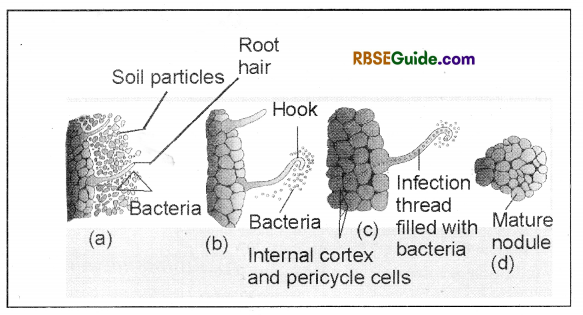
Note : In symbiotic N2 fixation two types of proteins have special significance. These are :
1. Leg haemoglobin
- The active nodules of leguminous plants (which fix nitrogen) have pink or red coloured pigment called leg haemoglobin.
- This pigment absorbs oxygen during nitrogen fixation.
- The nitrogen fixing enzyme nitrogenase is highly’ sensitive to the presence of oxygen and is active only under anaerobic conditions (in the absence of O2) and becomes inactive in the presence of oxygen.
- Thus by absorbing O2 leg haemoglobin, prevents inactivation of nitrogenase enzyme.
- Hence in the absence of leg haemoglobin, fixation of nitrogen is not possible because oxygen inactivates nitrogenase enzyme.
2. Nodulin Protein : This protein can be of several forms depneding upon the structure of nodule and nitrogen and carbohydrate metabolism.
Note : Symbiotic N2 fixation is the outcome of mutual co-operation and expression of genes found in the genome of two symbionts.
In fixation of atmospheric N2 into nitrogen compounds the Nod gene of the host and Nod, Nif and Fix genes of the bacterium play special role. ‘‘The Nod gene plays important role in nodule formation where as AT/’and Fix genes play important role in N2 fixation.
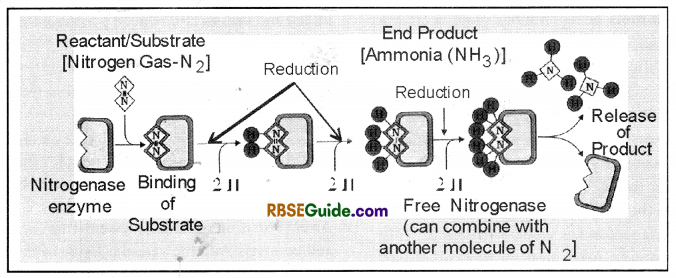
Mechanism of Symbiotic N2 Fixation
- Symbiotic nitrogen fixation is completed in the root nodules of leguminous plants.These nodules contain nitrogenase enzyme and leghaemoglobin protein pigment is necessary for N2 fixation.
- Synthesis of nitrogena se enzyme is controlled by the Nif gene of Rhizobium
- Nitrogenase is a complex enzyme and besides protein it contains molybdenum (Mo) and Iron (Fe) elements.
- Nitrogenase enzyme converts free atmospheric nitrogen into ammonia and uses ATP energy in the process. The process can be represented by following reaction.

Assimilation of Ammonia
- Ammonia and ammonium ions formed during biotic N2 fixation are toxic for plants, hence Ammonia formed in this process is used in the formation of amino acids. This is completed by two methods :
(i) Reducing animation
In this process ammonia first reacts with a-Ketoglutaric acid and forms glutamic acid.

(ii) Transaminase reaction :
In this process amino group of one aminoacid is transferred to one keto-acid. As a result a new amino acid is formed.
Reactions
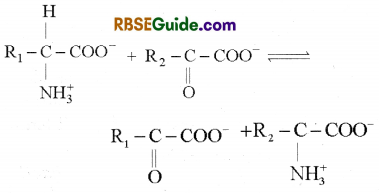
By transmination, about 17 types of amino acids can be synthesized.
(B) Ammonification
1. The organic compounds present in soil decompose to form ammonia or ammonium compounds. This process is called ammonification.
2. Nitrogen absorbed by plants in the form of inorganic compounds is converted in to various organic compounds during nitrogen assimilation.
3. From plants these compounds may pass to animals.
4. After death and decay of plant and animal these organic compounds pass to soil where these are decomposed by microorganisms and nitrogen is released in the environment in gaseous form.
![]()
5. This decomposition is brought about by putrefying bacteria present in soil by following steps :
- Proteolysis : In this process proteins are broken down to amino acids.
Example : Clostridium, Pseudomonas - Deamination : In this process amino acids are broken down and ammonia formed during the process is released to atmosphere.
Example : Different specis of Bacillus.
(C) Nitrification
1. The process of oxidation of ammonia into nitrate is called
2. This is brought about by different types of chemosynthetic bacteria and the process is completed in two steps.
(a) Conversion of NH3 into Nitrite
Ammonia (NH3) is first oxidized to nitrite by Nitromonas

(b) Conversion of Nitrite into Nitrate
Nitrite is further oxidized to nitrate by the bacterium
![]()
(D) Denitrification
The process of degradation of nitrate present in soil into free nitrogen is called denitrification. This results into loss of nitrate compounds of soil and the soil fertility declines.
Denitrification is brought about by Thiobacillus denitrificance, Bacillus denitrificance and Pseudomonas denitrificance.
Note : The N2 cycle completed in the above four steps can be represented by following figure.
